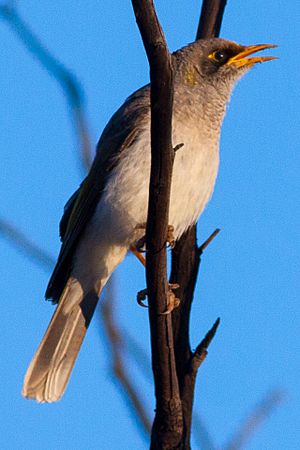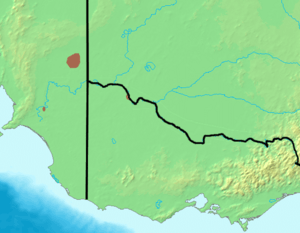Black-eared miner facts for kids
Quick facts for kids Black-eared miner |
|
|---|---|
 |
|
| Conservation status | |
| Scientific classification | |
| Genus: |
Manorina
|
| Species: |
melanotis
|
 |
|
| Distribution of the black-eared miner | |
The black-eared miner (Manorina melanotis) is a special type of honeyeater bird. It lives only in the mallee woodlands of south-eastern Australia. This bird is currently listed as endangered, meaning it is at high risk of disappearing forever.
Contents
What is a Black-eared Miner?
The black-eared miner is a unique bird found only in Australia. It is part of the honeyeater family, which are known for eating nectar from flowers. These birds are very social and live in groups.
Family Tree: Related Birds
The black-eared miner is closely related to another bird called the yellow-throated miner. The yellow-throated miner is much more common and lives in many places. Some scientists even think the black-eared miner might be a special kind of yellow-throated miner. They are still studying this to be sure.
How Black-eared Miners Live
Black-eared miners are known as "co-operative breeders." This means that during the time they lay eggs and raise their young, many birds in the group help out. They live together in colonies. When it's not breeding season, they spread out into the bush. Scientists are still learning about where they go during these times.
Where They Live and Their Home
Black-eared miners need a specific type of home called mallee woodland. This is a special kind of forest with certain trees and plants. They are found in parts of north-western Victoria and south-eastern South Australia.
Important areas for these birds are called Important Bird and Biodiversity Areas (IBAs). These places have healthy mallee woodland that the birds need to survive. Some of these key areas include:
- Murray-Sunset, Hattah and Annuello
- The Riverland Mallee
- Wyperfeld, Big Desert and Ngarkat
Protecting the Black-eared Miner
The black-eared miner is an endangered bird. This means there are not many of them left, and they need our help to survive. The Australian government lists them as endangered under a law called the Environment Protection and Biodiversity Conservation Act 1999.
Different states in Australia also have laws to protect them:
- New South Wales: Listed as "Critically Endangered." This is the highest level of risk.
- South Australia: Listed as "Endangered."
- Victoria: Listed as "Threatened" and "endangered." Victoria has a special plan to help this bird recover.
Images for kids
See also





